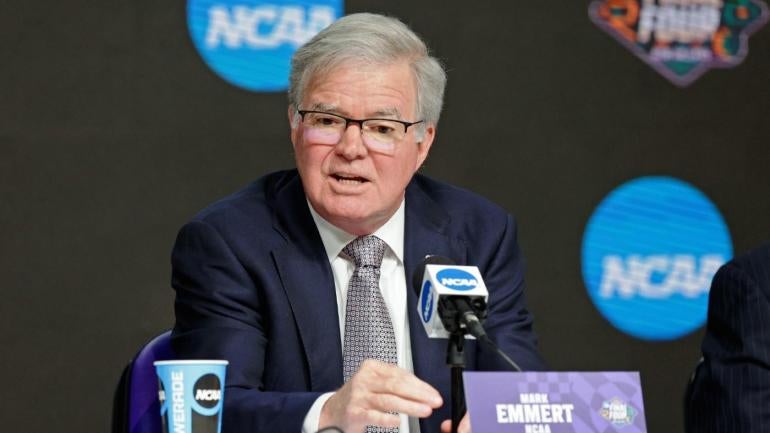
NEW ORLEANS – Mike Krzyzewski had questions. Actually several of them. The opportunity came during an aside at Duke's media availability here for the Final Four.
Somehow the conversation veered off the great coach's chase of a sixth national championship into the upcoming press conference with NCAA president Mark Emmert.
"I have many questions [of Emmert]," Coach K said. "I think the very first one is where are we going? And who is going to be in charge? Not that I'm saying that [Emmert] shouldn't be. But what are we doing?"
Those questions have been asked for years – decades, actually. Now there is a soft deadline of Aug. 1 for their answers. That's the deadline for the NCAA Transformation Committee that is attempting to do the heavy lifting out of the muck the association is stuck in. That committee is expected to forward a series of recommendations to reshape the NCAA Constitution that could change the look of college athletics forever.
Speaking post-Krzyzewski Thursday at his annual Final Four availability, Emmert made it sound like the NCAA had accepted its diminished role. There was the same old asking Congress for help on NIL that may never happen. The NCAA's credibility on that subject has already been altered by two huge anti-trust losses in federal court (The O'Bannon and Alston cases) as well as name, image and likeness.
Then Emmert dropped a bit of a bomb.
"We've got a relatively short window of time in my estimate -- one or two years these decisions have to be made because of the dynamics that are underway right now," he said.
"The legal landscape as it exists today simply will not support and sustain the way college sports is conducted today," Emmert added.
One or two years or what? Add that to the list of Krzyzewski's questions. It's rather disingenuous to blame "the legal landscape" on college athletics' current predicament. The NCAA helped shape that legal landscape. Now, the association is increasingly helpless to stop those college athletics from becoming a semi-pro enterprise at the highest level.
One or two years or what? No more NCAA? There are already signs Congress could step in and run the enterprise. A bipartisan bill is expected to be filed this week that would speed up the enforcement process. https://www.si.com/college/2022/03/29/ncaa-infractions-cases-congress-bipartisan-bill
Meanwhile, NIL has … worked? It certainly hasn't been the ruin of college athletics. For decades the NCAA's legal defense when any kind of player compensation came up, was the same. If players were paid, TV ratings would go down, attendance would go down, interest would diminish. That defense doesn't hold up anymore. Not in court, not in the court of public opinion. In fact, NCAA senior vice president of basketball Dan Gavitt on Thursday rattled off a series of attendance benchmarks that had been reached with the men's and women's tournament.
I asked Emmert directly: What evidence did he have that interest, ratings and attendance had declined since the July 1 implementation of allowing NIL compensation.
"Clearly the social and political landscape has shifted pretty significantly in a whole variety of ways in the last 12-24 months," Emmert said. "We're going to be ready, willing and able to shift in dramatic ways."
That evaded the question. The truth is the NCAA got terrible legal advice taking Alston to the Supreme Court. It chose to go to war over giving more educational benefits. Emmert said "conference lawyers, NCAA lawyers and our external lawyers" made the decision. The NCAA Board of Governors signed off on it.
That 9-0 June decision by the Supreme Court effectively caused the association to reconsider its constitution. Now that transformation committee has until August to "fix" the NCAA.
Transformation co-chairs Greg Sankey (SEC commissioner) and Julie Cromer (Ohio AD) met with the media off to the side after Emmert's remarks. Their pairing signifies the monumental task ahead. Sankey is head of the most powerful conference in the land. The expenses of Cromer's department is $26 million. At Alabama that number is $170 million.
There is no certainty the two biggest tasks for the committee will be completed by the deadline. That is paring down enforcement and deciding the membership dilemma. That is, who exactly should be in Division I.
"That doesn't mean everybody will like the process. That doesn't mean it will be perfect," Sankey said of the committee's ongoing work.
But will it be on time and what is Emmert talking about with a vague one-to-two year timeline on the whole enterprise? Coach K, among others, would like to know.
"He is not the only person who is disenchanted with the current system," Cromer said.
And now the clock is ticking. Sankey said the committee asked the Board of Governors up front: Are you serious about this task? Do you want all of this done by August?
"The Board said be expeditious but be thorough. I think there is a level of flexibility but I don't think either of us is looking at this co-chair role as a retirement opportunity," Sankey said.
That statement suggests the 21-person committee could disband after Aug. 1. Other committees could take over – the NCAA takes sustenance from them – but that doesn't solve the problem of saving the NCAA within the next two years.
"We have legal outcomes that say, not changing is not an option. How that manifests itself remains to be seen …," Sankey said. "We're [membership] really good at making rules, not really good at deleting rules."

















